
Modern businesses often aim to enhance customer communication and drive engagement using A2P messaging. This powerful tool enables businesses to send automated text messages, ensuring timely and targeted communication. But how exactly does A2P messaging work, and is it suitable for your business? Well, if you are seeking answers to these questions, you should read this post. I will cover various aspects related to A2P messaging, including benefits, use cases, numbers that can be used, governing laws, and the ideal platform you can use.
What is A2P Messaging?
In our daily lives, we receive a lot of messages from various businesses. It can be a text message from your favorite brand offering festive discounts. Or there could be a message from your bank informing you about the maturity of your fixed deposit. There are many examples (and we’ll discuss them right after this). Statistically, by 2025 the global A2P messaging market size is expected to grow to USD 72.8 billion from USD 62.1 billion. Source – GlobeNewsWire
In A2P messaging the communication is initiated by a business or enterprise (using a software application to send these messages) and is sent to the recipient’s phone. It is completely different from other forms of messaging such as P2A and P2P where communication is initiated by a person first.
Also called as business messaging or enterprise messaging, A2P messaging is usually automated (instead of manual typing and sending, programs are used) and targets a large volume of audience. It is important to note that in communication through A2P messaging, replies from the recipients are not expected. A simple example can be a health clinic sending appointment reminders to their patients where the aim is to communicate the appointment schedule and no action/ reply is required from the receivers.
Examples of A2P Messaging
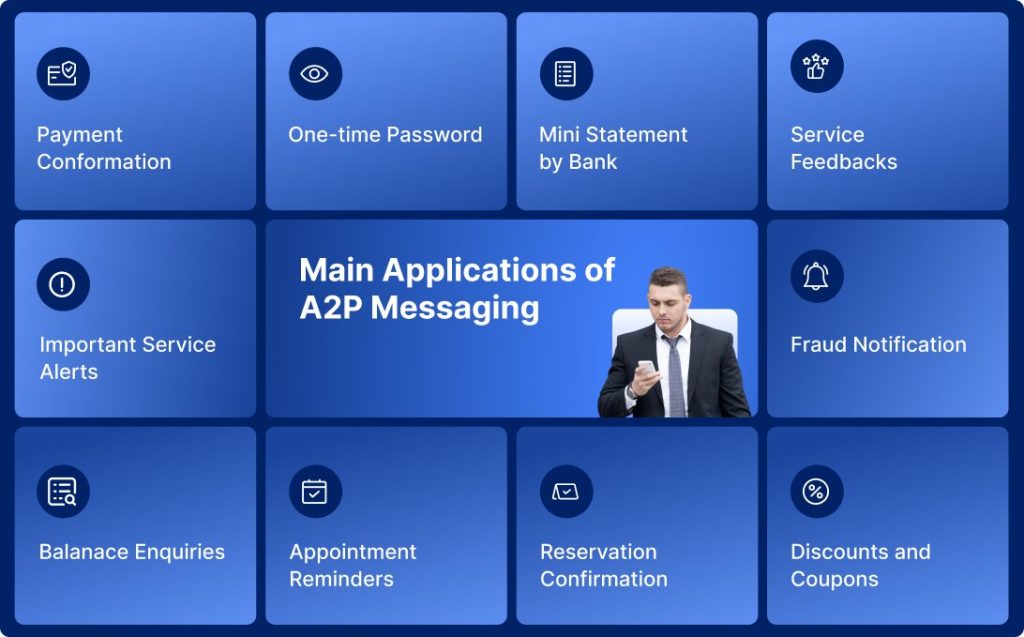
Let’s take some more examples to understand the practical use of A2P messaging in the real-world.
- 2 Factor Authentication or 2 FA
Banking and financial institutions use A2P messages for secure authentication and verification of customer logins. One-time passwords or OTPs are sent to customers via SMS messages which they have to enter while logging in to their banking accounts.
- Alerts and Notifications
Any important announcements such as low balance alerts, suspicious activity alerts, package shipping and delivery alerts, etc. are sent to customers via A2P messaging.
- Voting and Surveys
Another way businesses use A2P messaging for active customer engagement is through voting and surveys. Customers are asked to cast their vote by clicking on the link provided in the message and selecting the preferred option. Similarly, feedback about products and services is also gathered through messages.
- Marketing Campaigns
As previously mentioned, businesses often send discount codes, sale alerts, promotional offers, etc., through messages.
How A2P Messaging Work?
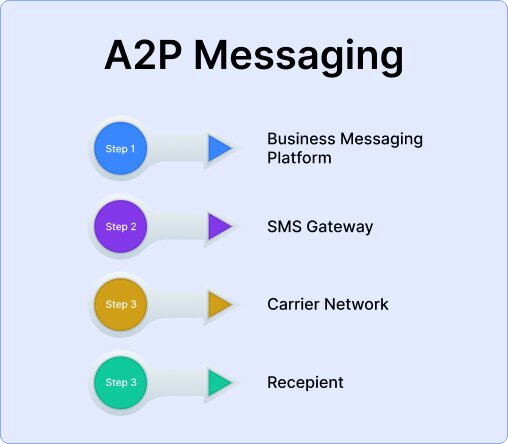
1. It starts when an A2P messaging application or software triggers a message on the basis of a predefined event or condition or action. A simple example is of a transaction message that triggers as soon as a customer performs a transaction.
2. From the software application, the message is routed to SMS gateway, which is an intermediary unit between the application and SMSC.
3. The message is then delivered to the respective recipient’s mobile device.
How is A2P Messaging Different From P2P and P2A Messaging?
A2P messaging mainly has one counterpart: P2P. We will take a detailed look into this messaging style to understand their differences.
What is P2P Messaging?
P2P stands for Person-to-Person messaging which means one persons sends message to another person. So P2P is basically personal messaging like we send messages to our friends and family and they reply us back. Unlike A2P, P2P messages are not automated i.e. the person manually enters the message.
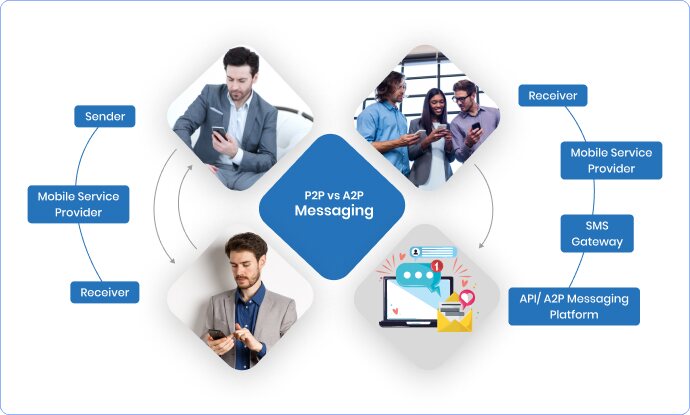
Besides P2P messaging, it is important to understand yet another messaging technique called P2A i.e. person to Application messaging. The next section gives you a detailed explanation about P2A messaging.
What is P2A Messaging?
In this type of communication, an individual or a customer sends a message to the application/business. It is the reverse of A2P messaging where the application sends a message to the individual. Some common examples where P2A messaging is used include subscribing to services, contacting customer support, etc.
Below is a detailed table highlighting the differences between A2P, P2P and P2A messaging.
| Feature | A2P Messaging | P2P Messaging | P2A Messaging |
| Sender | Application or System | Individual | Individual |
| Recipient | Individual | Individual | Application |
| Purpose | Business communication, marketing, notifications | Personal communication | User interaction with applications |
| Volume | High volume, often automated | Low to medium volume, typically manual | Varies, often triggered by user actions |
| Examples | Marketing campaigns, appointment reminders, order confirmations, OTPs | Text messages between friends, family, or colleagues | Voting in polls, subscribing to services, providing feedback |
| Regulatory Compliance | Stricter regulations due to commercial nature | Less stringent regulations | Often subject to specific application’s terms and conditions |
| Security | Robust security measures to protect sensitive information | Standard security measures for mobile devices | Security measures implemented by the application |
Benefits of A2P Messaging
What makes A2P a good outreach choice? Well, the reasons are many. A major benefit of using A2P messaging is that it helps businesses send messages to a large group of people all at once without compromising on personalization. Yes, A2P messaging can pull data from your database systems and insert them into messages keeping them personalized. Suppose you need to send your order status messages to 20,000 customers at the same time. The A2P messaging system can fetch order status information for each recipient from the database and insert it into the messages. This way it helps maintain one-to-one communication without consuming much time and effort.
High Engagement Rates
Tell me what’s that one gadget we can’t imagine life without? It’s certainly our mobile phones – they are ubiquitous and indispensable, right? Whenever a notification arrives, it’s normal for all of us to quickly check that notification – it’s hard to resist. The ‘forever within reach’ of mobile phones together with the habit of checking mobile phones often, results in excellent engagement rates. Even the facts tell the same story, check it out:
“SMS messages have an open rate of around 98%, which is much higher than the 20% open rate for emails.” Source – Forbes
Direct and Instant Communication
A2 messages offer immediate delivery which is quite crucial in time-sensitive communication such as emergency alerts, and real-time interactions.
Cost Effective
If we compare A2P messaging with traditional methods of customer communication such as direct mail or print, then certainly it is a cost-effective approach. Most of the A2P messaging service providers charge very nominal for bulk messaging which helps businesses save a lot while they easily communicate with large audiences.
Enhanced Operational Efficiency
Since A2P messaging can be automated, it eliminates a lot of manual and redundant effort of the business, thus increasing operational efficiency. Also, when the messaging process gets automated, businesses are better able to streamline their tasks.
Send High-Volume SMS Campaigns
While other forms of messaging such as P2P are limited by individual user constraints, A2P messaging is especially designed to help businesses send mass text messages in one go. A2P messaging utilize SMS gateways, operator-level integration which makes it ideal for businesses targeting large-scale SMS campaigns without getting marked as spam.
Helps Avoid Spam Traps
A2P messaging implements strong spam prevention mechanisms through formal process of brand registration, campaign vetting and whitelisting by the carriers. This is done to distinguish A2P messages from regular P2P messaging so that these messages bypass spam filters. So even when messages are sent in high volumes, they are not flagged or blocked, creating a secure and regulated framework for business communication.
Offers Flexible Implementation Options
Another significant advantage of A2P messaging is that it offers businesses with the flexibility to implement it as per their choice. Mainly, there are 3 options – 10DLC numbers, shortcodes, and toll-free numbers, with each offering its own set of advantages. Therefore, depending upon the specific needs, messaging volume and budget, a business can use the most appropriate method for their SMS campaigns.
Goes Beyond Simple Text Messaging
A2P messaging incorporates advanced texting features such as automated and scheduled-based texting, analytics, message status tracking, adding notes, and a lot more. All these features enable businesses to reduce their manual effort while maintaining consistent customer engagement.
Offers Customization
A2P messaging solutions come with message personalization features so that you can customize texts that recipients can resonate with. By adding information that caters to the recipient’s interests and demographics, you can create tailored messages that can drive more engagement and response rates.
Integrate Seamlessly
A2P business texting software integrates seamlessly with other business applications such as CRM , helpdesk software, customer support platforms, marketing and automation platforms and even e-commerce and payment gateways. Such integration makes it easier for organizations to benefit from a unified customer view with all customer conversations an data stored in one place.
What Numbers to Use for A2P Messaging?
The type of number used for sending messages when using A2P messaging can make or break the success of your business campaigns. Mainly there are 3 options to choose from – 10DLC numbers, Shortcodes and Longcodes. Each number type offers unique usage and benefits. So let’s explore more about which number is right for your business.
1. 10DLC
Also called 10 digit long code, these numbers are simply 10-digit regular phone numbers. By registering with their carriers to use 10DLC numbers, businesses can send messages their customers through these numbers. So the next thing you obviously want to know is: what’s the benefit for a business to use a 10DLC or a 10 digit phone number to send SMS campaigns? What makes these numbers special is that they bridge the gap between those traditional long codes and short codes
Well, there are mainly 2 benefits, as mentioned below:
- Maintain Local Presence
As these numbers resemble the regular phone numbers that people use, which makes them more familiar and trustworthy to the recipients. When messages are received from local-looking or familiar numbers, the likelihood of getting opened and engaged is quite more.
- Two-way Messaging
Another benefit of using these numbers is that they support two-way messaging. This means that businesses can engage in real-time conversations with customers which is especially useful for customer service, feedback collection, etc.
2. Shortcodes
As the term suggests, these are only 5-6 digit numbers. We can also say that these are shortened phone numbers that businesses can use to send and receive text messages. One major benefit of using these concise numbers is that they are easy to recall making it easier for customers to remember and use.
Shortcodes are mainly of two types:
- Shared Shortcodes
These short codes are shared among multiple businesses by using some keywords to distinguish between campaigns, for example, Text BURGER to 45678. These codes are best for businesses with budget constraints, however, these codes are not being used in some regions due to compliance and security reasons.
- Dedicated Shortcodes
The numbers used by modern-day businesses who exclusively own and use them. We can say that a short code is unique to a business which is why these are ideal for larges-scale SMS campaigns and branding.
3. Toll-Free Numbers
Just like 10DLC, toll-free numbers are also 10-didgit phone numbers, with the difference that these numbers begin with prefixes like 888, 880, 866, 877, 855, 844, 833. Primarily, these numbers are used for voice calls where the receiver is charged for the call, however, in recent times, toll free numbers are being effectively used for A2P messaging. Some typical characteristics of toll-free numbers include the ability to handle medium-volume message broadcasts, cost-effectiveness and a professional approach to connected with customers via SMS messages.
| Number Type | Description | Pros | Cons |
| 10-Digit Long Code (10DLC) | 10-digit phone number | High throughput, low cost, personalized branding | Requires brand and campaign registration, potential for filtering |
| Short Code | 5-6 digit number | High brand recognition, high throughput | Expensive, limited availability, strict regulations |
| Toll-Free Number | 10-digit phone number with 800, 888, 877, 866, or 855 prefix | Professional image, easy to remember | Higher cost, potential for voice calls |
Laws and Regulations Governing A2P Messaging
Like every technology, A2P messaging is also surrounded by various laws and regulations that one should comply to. Two major regulations include:
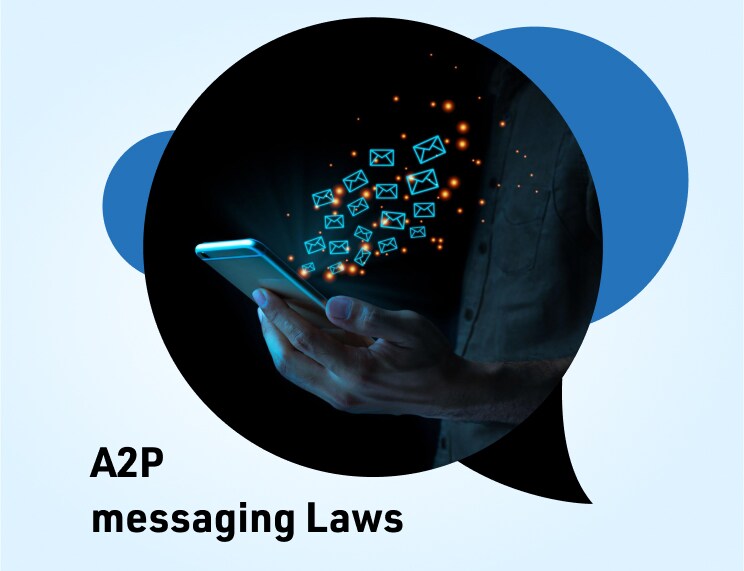
1. TCPA
The Telephone Consumer Protection Act in the United States governs the way in which businesses can use automated programs or systems to send messages to customers. In its broadest sense, the law requires businesses to:
- Obtain explicit consent from customers to receive messages
- provide an opt-out option to customers every time they receive a message
- Sending messages only within the specified hours
2. FCC
The Federal Communications Commission (FCC) in the United States provides A2P messaging guidelines which are as follows:
- Obtain consent from all recipients to receive messages. The consent must be documented and stored for reference.
- Every message should come with the instructions for recipients about how they can stop receiving further communications
- Messages should be clear and not misleading
- There should be compliance with carrier requirements for A2P messaging
3. GDPR
The General Data Protection Regulation in the European Union primarily focuses on protecting the personal data and privacy of EU residents. The law requires businesses to:
- Obtain explicit consent from consumers before sending SMS messages
- Customers should be informed about how their data will be used
- Provide an opt-out option so that consumers can withdraw from receiving messages easily
- Ensure that personal data is securely stored and processed.
There are several other such laws regulated in different regions around the world including CASL ( Canada’s Anti-Spam Legislation), TRAI (Telecom Regulatory Authority of India), and CTIA (Cellular Telecommunications Industry Association) that businesses need to follow. One should understand that it is not just about adhering to these laws and avoiding penalties, rather by following these laws, businesses can effectively engage with their audience while making sure that legal and ethical standards are maintained.
Best Practices for A2P Messaging Compliance
What did we conclude from the above-mentioned rules and regulations? Well, let’s take a look at some of the best practices businesses must follow to comply with A2P messaging regulations.
- Obtaining clear and verifiable consent from your audience before sending the messages.
- Provide them with a simple way to opt-out.
- Fulfill your carrier’s requirements i.e. registering your numbers and campaigns
- Adhere to carrier-specific content guidelines, such as avoiding spam keywords and excessive links.
- Use a recognizable and trustworthy sender ID to build trust with recipients.
- Send messages at appropriate times to avoid disturbing recipients.
- Regularly clean your contact list to remove invalid or unsubscribed numbers.
Which Platform to Use for A2P Messaging Services?
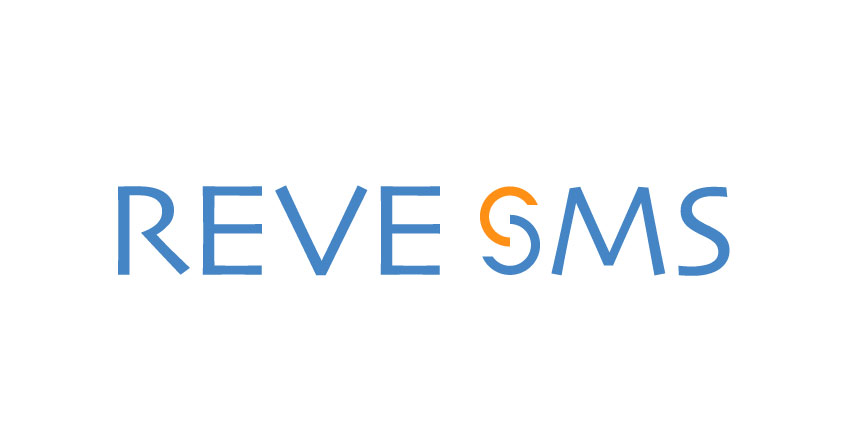
If you are already in the SMS business or are interested in joining this industry by becoming an A2P SMS Aggregator, then you certainly need a robust SMS platform equipped with advanced messaging features.
REVE SMSC or REVE SMS platform is not just a messaging platform but rather a comprehensive solution designed specifically for SMS aggregators, MNOs, and MVNOs to help them deliver A2P messaging services with complete ease. Our platform supports all types of messages such as Promotional, Bulk SMS, Transactional and Response-driven SMS, etc.
How to Choose an A2P Messaging Provider?
When selecting the right A2P messaging provider, consider these key points:
- Look for a provider with reliable infrastructure because it is crucial for uninterrupted services
- It is better to opt for a provider that offers flexible API integration so that you can seamlessly integrate your existing systems
- Ensure the availability of real-time analytics to gain valuable insights into your A2P messaging campaigns
- Always prefer a provider that adheres to industry standards and regulations
- Get a clear understanding about the pricing structure including monthly charges, per-message cost and any hidden or additional charges
- Verify that the provider offers reliable customer support because it is essential for quick issue resolutions
Frequently Asked Questions
Which industries can use A2P messaging?
Almost every industry that requires communicating with customers can use A2P messaging. This includes e-commerce, banking, hospitality, education, etc.
Can businesses track the performance of A2P SMS campaigns?
Yes, by tracking metrics like delivery rates, open rates, response rates, and opt-out rates can help businesses evaluate the effectiveness of their A2P campaigns.
What are some effective ways to ensure A2P messages are not marked as spam?
Some effective ways are registering campaigns with carriers, obtaining explicit consent from the customers, providing opt-out options with every message.
How to include an opt-out option in A2P messaging campaign?
You can add a clear and concise opt-out instruction in every message. For example, by including “Send STOP to 12345” in your A2P messages provides customers with a straightforward and simple way to opt-out.
Do carriers check A2P SMS campaigns?
Yes, before a campaign passes from a carrier’s network, it is reviewed and approved by the carrier to ensure compliance and spam prevention. This process is called campaign vetting.






















